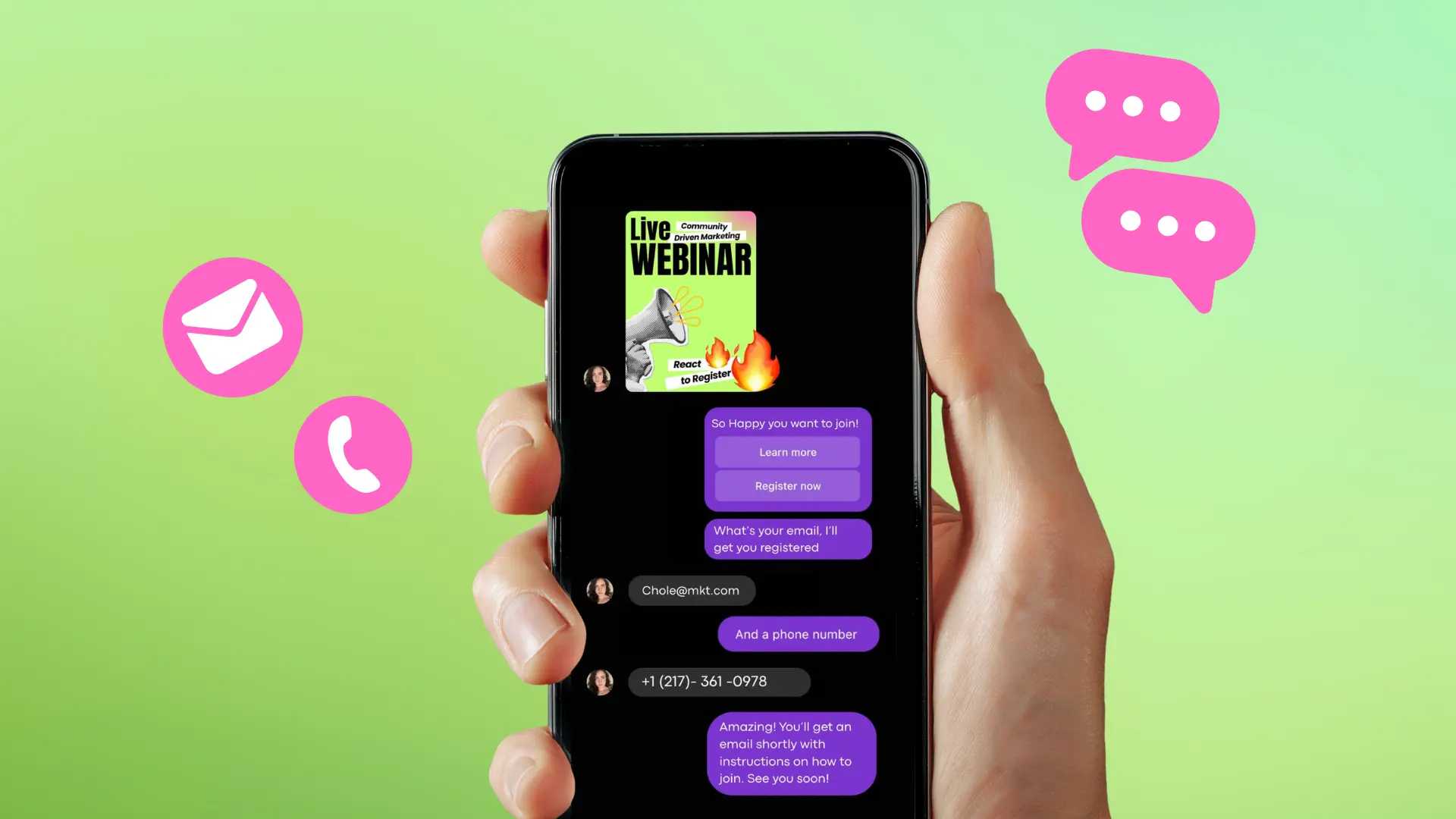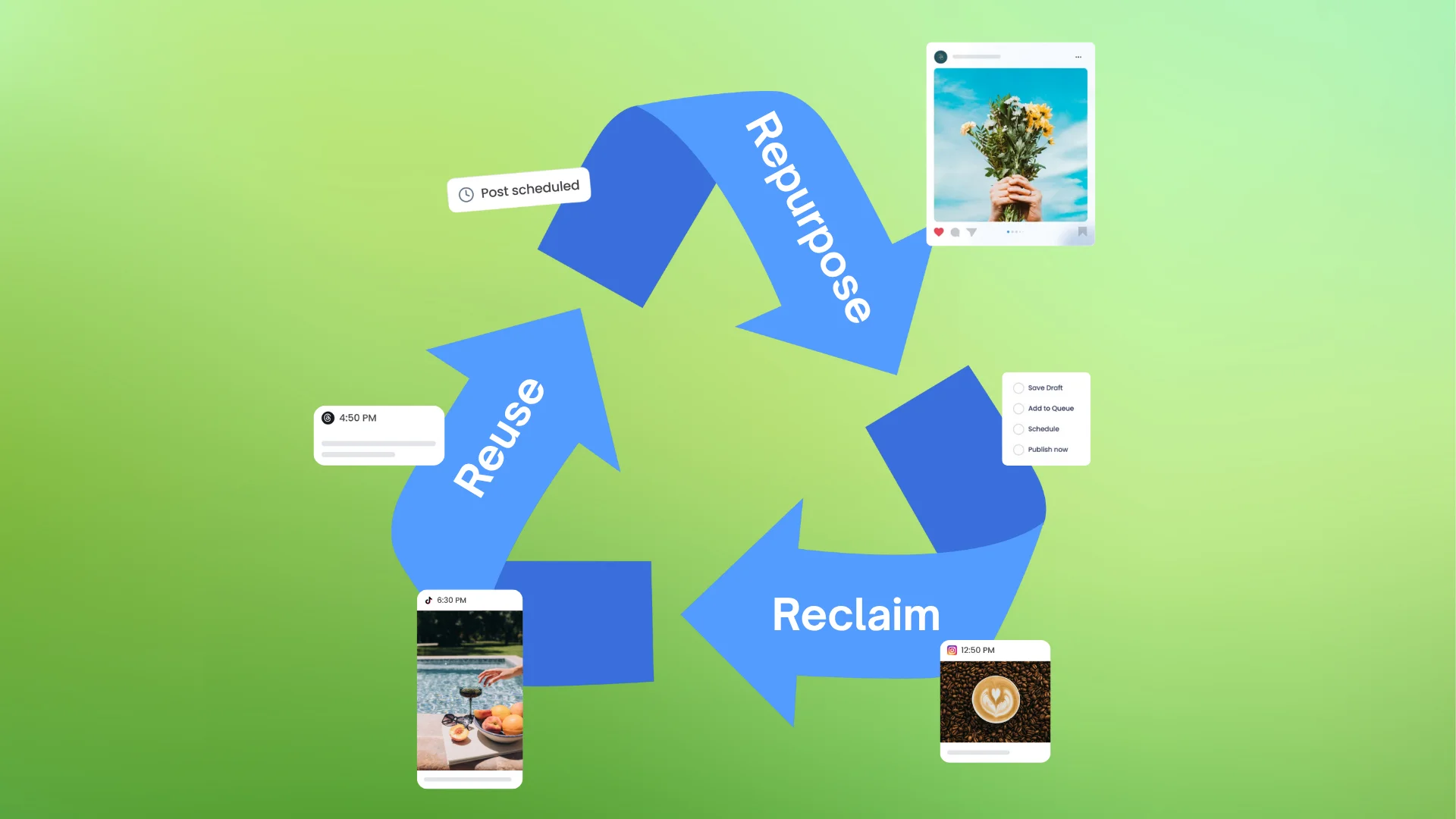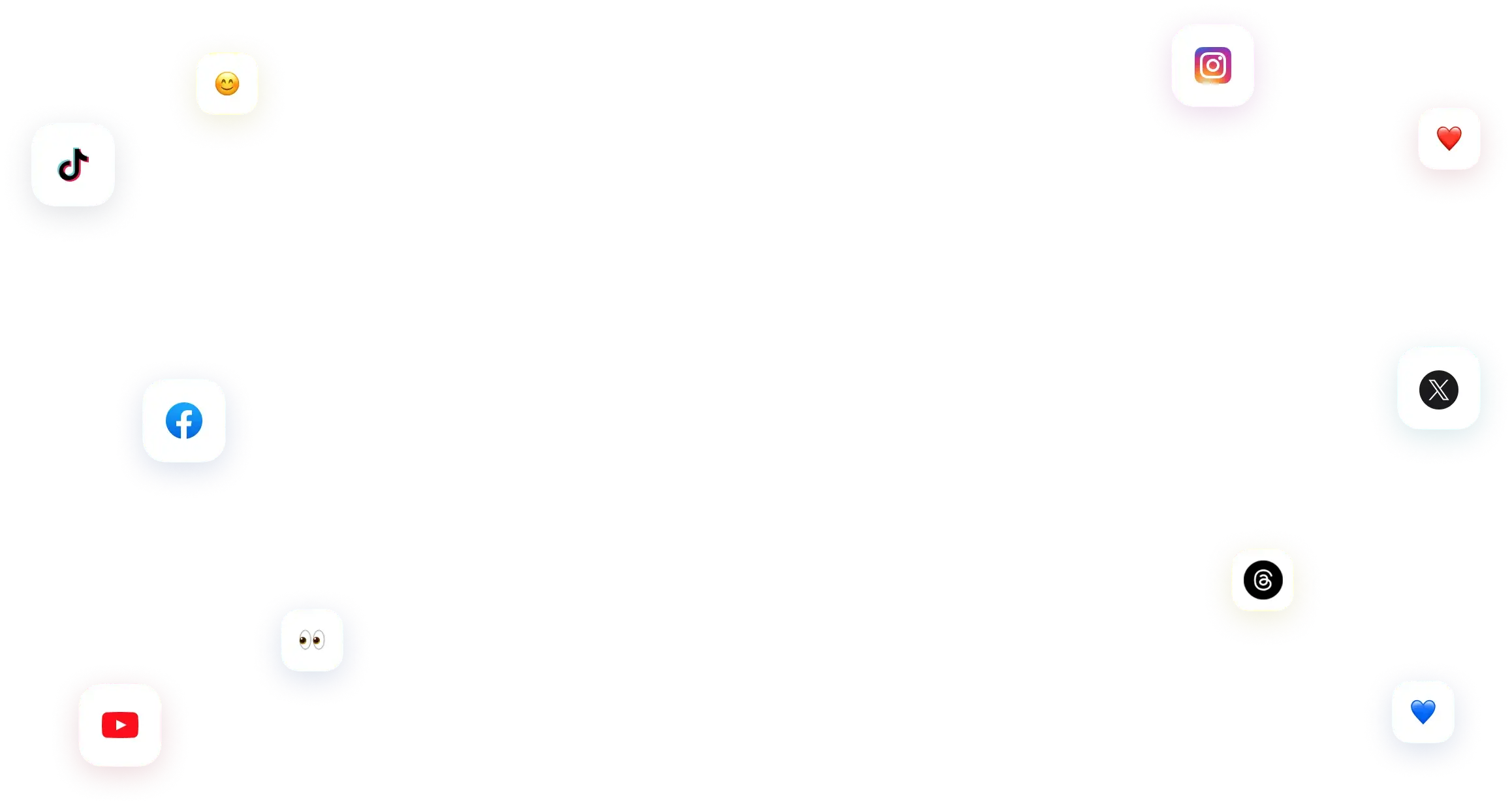New

Turn Your DMs Into Lead Gen!
Learn how to collect lead data from your DMs such as email addresses, phone numbers, and more right from your social inbox. If you are not yet automating your DMs your competitors are outpacing you.

How Something Social Saved 75% of Their Time and Increased Revenue by 15%
See how a fast-growing agency improved operations, cut down hours of manual work, and unlocked new revenue opportunities with Vista Social.
New

50 Unique Social Media Ideas for Consistent Content Creation
Discover 50 unique social media post ideas to engage your audience, grow your brand, and maintain a consistent content strategy with ease!

Mastering Content Reuse: The Key to a Consistent and Sustainable Posting Strategy
Published on August 12, 2025
9 min to read
The Complete Guide to Social Media ROI Measurement in 2025
Summarize with AI


Table of Content

Here’s the thing about social media marketing: everyone’s doing it, but most people can’t prove it’s actually working. Learning how to measure social media ROI is what separates the pros from the people just posting and hoping for the best.
Social media advertising spend is projected to reach $276.7 billion in 2025, with businesses putting serious money behind their social strategies. But here’s the problem—most of them can’t tell you if it’s working.
This guide will show you exactly how to measure social media ROI so you can finally prove your social media efforts are worth every penny. We’ll cover the simple formula, the metrics that actually matter, and the tools that make tracking super easy.
Table of contents
What is Social Media ROI?
Think of social media ROI like this: it’s figuring out how much money you make compared to how much you spend on social media. Pretty straightforward, right?
However, unlike running a newspaper ad where someone sees it and buys immediately, social media works differently. For example, someone might see your Instagram post today, follow you, watch your stories for weeks, then finally buy something next month.
That’s why knowing how to measure social media ROI properly is so important. Additionally, you need to capture all that value, not just the obvious “someone clicked and bought” moments.
Most marketers get stuck looking at likes, shares, and follower counts. Unfortunately, these “vanity metrics” might make you feel good, but they don’t tell you if you’re actually making money. Instead, the goal is to connect your social media work to real business results like:
- More website traffic that converts to sales
- Email signups that become customers
- Brand awareness that leads to word-of-mouth referrals
- Customer service interactions that prevent cancellations
The Social Media ROI Formula and Key Metrics
Here’s the basic formula for how to measure social media ROI: [(Earnings – Costs) ÷ Costs] x 100
- Earnings = Revenue generated from your campaign
- Costs = Expenses like hours worked, content production, ad spend, etc.
Essential Metrics for Social Media ROI
First, revenue attribution and conversion tracking forms the foundation of measuring social media ROI. This means tracking how social media contributes to actual sales through:
- Direct purchases from social commerce features
- Sales from people who clicked through from social posts
- Discount code usage from social campaigns
- Revenue from leads generated through social media
Next, customer acquisition cost (CAC) from social channels helps you compare social media to other marketing methods. For instance, if it costs you $30 to get a customer through social media but $150 through Google ads, you know where to focus your budget.
Additionally, customer lifetime value (CLV) impact matters because social media often attracts loyal customers who stick around and buy repeatedly. These customers might spend less initially but way more over time.
Furthermore, brand awareness and sentiment improvements can be tracked through:
- Brand mention increases
- Share of voice compared to competitors
- Sentiment analysis of social conversations
- Branded search term growth
Finally, lead generation and qualification metrics are crucial for businesses with longer sales cycles:
- Email newsletter signups from social media
- Demo requests and consultation bookings
- Contact form submissions with social media sources
- Sales qualified leads (SQLs) attributed to social efforts
Advanced Metrics Worth Tracking
First, engagement quality goes beyond counting likes and shares. Comments and saves typically indicate higher intent than passive likes. Therefore, look for engagement that leads to meaningful conversations or actions.
Second, organic reach value helps you understand what you’d pay for equivalent paid advertising exposure. For example, if your organic post reaches 10,000 people and similar paid ads cost $0.50 per impression, that’s $5,000 in equivalent value.
Finally, social commerce performance tracks direct sales through platform shopping features. Over 70% of Instagram users have purchased products they discovered on the platform, making this metric increasingly important.
5-Step Framework for Social Media ROI Measurement
Step 1: Define Clear Goals and KPIs
Start by aligning your social media goals with bigger business objectives. However, don’t just say “increase engagement”—get specific about what success looks like:
Brand awareness goals:
- Increase branded search traffic by 25%
- Grow share of voice by 15% compared to competitors
- Boost brand mention sentiment from 60% to 75% positive
Lead generation goals:
- Generate 200 qualified leads per month through social content
- Achieve 15% of total website traffic from social channels
- Convert 5% of social media followers to email subscribers
Sales goals:
- Drive 10% of total revenue through social media attribution
- Maintain customer acquisition cost under $50 from social channels
- Increase average order value from social traffic by 20%
Step 2: Set Up Proper Tracking and Attribution
This is where the magic happens—proper tracking lets you see exactly which social efforts drive results.
First, UTM parameter setup is your first step:
- Use consistent naming conventions across all campaigns
- Include source (facebook, instagram), medium (social), and campaign details
- Track different content types separately (video, carousel, single-image)
Next, multi-touch attribution gives you the complete picture. Most people interact with your brand multiple times before buying, so track:
- First-touch attribution (how people first discover you)
- Last-touch attribution (final interaction before conversion)
- Linear attribution (equal credit to all touchpoints)
- Time-decay attribution (more credit to recent interactions)
Finally, social commerce tracking requires platform-specific setup:
- Instagram Shopping tags and checkout
- Facebook Shop integration
- TikTok Shopping partnerships
- Pinterest Product Rich Pins
[Must Read: A Simple Introduction to Social Media Analytics and Intelligence]
Step 3: Calculate Your Social Media Investment
Time to add up what you’re actually spending. Most businesses underestimate their true social media costs.
First, team time and salary costs often represent your biggest investment:
- Content creators and designers (include planning, creation, and revision time)
- Community managers and customer service reps
- Social media managers and strategists
- Account managers who oversee social campaigns
Pro tip: Calculate fully-loaded hourly rates including benefits, not just base salaries.
Second, content creation and production expenses:
- Photography and videography
- Graphic design tools and software subscriptions
- Stock imagery and music licensing
- Props, equipment, and studio rental
- Freelancer and contractor fees
Third, advertising spend and promoted content:
- Platform advertising costs (Facebook Ads, Instagram promotions, etc.)
- Influencer partnership fees
- Sponsored content and brand collaborations
- Social media contest prizes and giveaways
Finally, tools and platform subscription costs:
- Social media management platforms
- Analytics and reporting tools
- Design software subscriptions
- Social listening and monitoring tools
Step 4: Measure and Track Returns
Try Vista Social for Free
A social media management platform that actually helps you grow with easy-to-use content planning, scheduling, engagement and analytics tools.
Get Started NowNow for the fun part—tracking what you’re getting back from all that investment.
First, direct revenue attribution works best for e-commerce and businesses with online sales:
- Use Google Analytics to track social media conversions
- Set up goals for different types of valuable actions
- Monitor social commerce sales through platform analytics
- Track discount code usage from social campaigns
Second, indirect value measurement helps service businesses and B2B companies:
- Calculate the value of leads based on historical conversion rates
- Track how social media affects sales cycle length
- Monitor customer lifetime value for social media-acquired customers
- Measure brand equity improvements through surveys and studies
Finally, long-term brand value assessment captures social media’s biggest benefits:
- Track organic search growth for branded terms
- Monitor customer retention rates for social vs. non-social customers
- Measure word-of-mouth referrals and customer advocacy
- Calculate the value of user-generated content and social proof
Step 5: Analyze and Optimize Performance
Regular analysis turns your data into actionable insights for better results.
First, monthly performance reviews should focus on:
- Which content types drive the best ROI
- What posting times and frequencies work best
- Which platforms deliver the highest-quality traffic
- How social media attribution compares to other channels
Next, quarterly strategy adjustments based on deeper analysis:
- Reallocate budget toward highest-performing platforms
- Double down on content formats that drive conversions
- Test new platforms or strategies based on audience behavior
- Update attribution models based on customer journey insights
Finally, continuous optimization tactics:
- A/B test different call-to-action phrases
- Experiment with posting schedules and content mix
- Test various UTM naming conventions for better tracking
- Refine targeting based on high-converting audience segments
Essential Tools for Social Media ROI Measurement
Getting the right tools makes learning how to measure social media ROI much easier. Here’s what actually works:
Google Analytics 4 provides the foundation for tracking social media’s impact on your website:
- Set up social media as traffic sources
- Create conversion goals that align with business objectives
- Use Enhanced Ecommerce tracking for detailed sales attribution
- Build custom reports focusing on social media performance
Native platform analytics offer detailed insights you can’t get anywhere else:
- Instagram Insights for Story and Reel performance
- Facebook Analytics for detailed audience demographics
- LinkedIn Analytics for B2B engagement and lead quality
- TikTok Analytics for video performance and trending content
Vista Social’s ROI measurement capabilities streamline the entire process by bringing everything together:
- Unified analytics dashboard that consolidates data from multiple platforms
- Automated reporting that saves hours of manual work each week
- Custom metric tracking for business-specific KPIs and goals
- Competitor benchmarking to see how your ROI compares to industry standards
- Cross-platform performance analysis that reveals which platforms drive the best results
- Scheduled report delivery to keep stakeholders informed automatically
CRM integration connects social media activities to actual sales outcomes:
- Track leads from social media through your entire sales funnel
- Calculate customer lifetime value for social media-acquired customers
- Monitor how social media influences deal size and sales cycle length
- Identify which social touchpoints contribute most to closed deals
[Must Read: 20+ Social Analytics Tools in 2025: Free And Paid]
Common Social Media ROI Measurement Mistakes to Avoid
Learning how to measure social media ROI means avoiding these common pitfalls that lead to inaccurate results:
Focusing only on vanity metrics like followers, likes, and shares provides limited business insight. These numbers might look impressive in presentations, but they don’t correlate directly with revenue or business growth. Instead, focus on metrics that connect to real business outcomes.
Not accounting for all costs results in artificially inflated ROI calculations. Include everything:
- Full team salaries and benefits (not just base pay)
- All software subscriptions and tools
- Content creation costs including revisions and planning time
- Opportunity costs of time spent on social media vs. other activities
Ignoring long-term brand value means missing significant ROI that builds over time. Social media’s biggest impact often comes from improved brand awareness, customer loyalty, and word-of-mouth marketing that pays dividends months or years later.
Failing to establish proper baselines makes it impossible to measure improvement accurately. Document your starting point before implementing new strategies:
- Current website traffic from social media
- Existing brand awareness and sentiment levels
- Historical conversion rates and customer acquisition costs
- Baseline engagement and reach metrics
Over-attributing or under-attributing social media’s impact leads to poor budget allocation decisions:
- Don’t give social media credit for sales that would have happened anyway
- Don’t ignore social media’s role in customer journey touchpoints
- Use proper attribution models that reflect your actual customer behavior
- Test incrementality to understand social media’s true added value
Advanced Social Media ROI Measurement Strategies
Once you’ve mastered the basics of how to measure social media ROI, these advanced techniques provide even deeper insights:
Multi-touch attribution modeling recognizes that customers typically interact with your brand multiple times before converting. Instead of giving all credit to the last click, advanced attribution:
- Maps the complete customer journey across all touchpoints
- Assigns appropriate credit to each social media interaction
- Reveals how social media influences customers at different stages
- Shows which combination of touchpoints drives the highest conversions
Incrementality testing and lift studies measure social media’s true incremental impact by comparing performance with and without specific activities:
- Run controlled experiments turning social media on/off for similar audience segments
- Measure the difference in conversion rates between test and control groups
- Calculate the true incremental value that social media adds to your business
- Identify which social media activities provide genuine lift vs. just correlation
Brand equity and sentiment value calculation quantifies the monetary value of brand improvements:
- Use brand awareness surveys to track improvements over time
- Calculate the correlation between brand sentiment and business performance
- Estimate the value of positive brand mentions and word-of-mouth referrals
- Model how brand equity improvements translate to future revenue
Customer journey analysis across touchpoints maps how social media influences behavior at different stages:
- Track awareness stage metrics like reach, impressions, and new followers
- Monitor consideration stage activities like website visits and content engagement
- Measure decision stage actions like demo requests and cart additions
- Analyze retention stage interactions like customer service and repeat purchases
Start Measuring Your Social Media ROI Today
The five-step framework we’ve covered—defining goals, setting up tracking, calculating investment, measuring returns, and analyzing performance—provides your roadmap for success in learning how to measure social media ROI.
Take these immediate actions to get started:
- Set up proper tracking today by implementing UTM parameters on all social media links and configuring Google Analytics goals
- Document your baseline metrics so you can measure improvement over time
- Choose 3-5 key metrics that directly connect to your business goals rather than trying to track everything
- Schedule regular review cycles for monthly performance analysis and quarterly strategy adjustments
Remember that consistency beats perfection. Start with basic ROI calculations and gradually add more sophisticated attribution and measurement techniques as your program matures. The most successful marketers are those who continuously refine their measurement approach and adapt their tracking as platforms and business needs evolve.
Vista Social’s comprehensive analytics and reporting capabilities can streamline this entire process, eliminating the manual work that often prevents teams from implementing robust ROI measurement. From automated cross-platform reporting to advanced attribution tracking, the platform provides everything you need to prove your social media value and optimize for better results.
P.S. Vista Social is a powerful all-in-one social media management platform designed for marketing agencies, freelancers, and social media managers. Our advanced tools boost collaboration, streamline workflows, and elevate your social media marketing success.
Sign up for your Vista Social account now to explore our features and take your social media strategy to the next level!
About the Author
Content Writer
Russell Tan is a content marketing specialist with over 7 years of experience creating content across gaming, healthcare, outdoor hospitality, and travel—because sticking to just one industry would’ve been boring. Outside of her current role as marketing specialist for Vista Social, Russell is busy plotting epic action-fantasy worlds, chasing adrenaline rushes (skydiving is next, maybe?), or racking up way too many hours in her favorite games.
Read with AI
Save time reading this article using your favorite AI tool
Summarize with AI
Never Miss a Trend
Our newsletter is packed with the hottest posts and latest news in social media.

You have many things to do.
Let us help you with social media.
Use our free plan to build momentum for your social media presence.
Or skip ahead and try our paid plan to scale your social media efforts.
P.S. It will be a piece of cake 🍰 with Vista Social
Subscribe to our Newsletter!
To stay updated on the latest and greatest Social Media news. We promise not to spam you!


